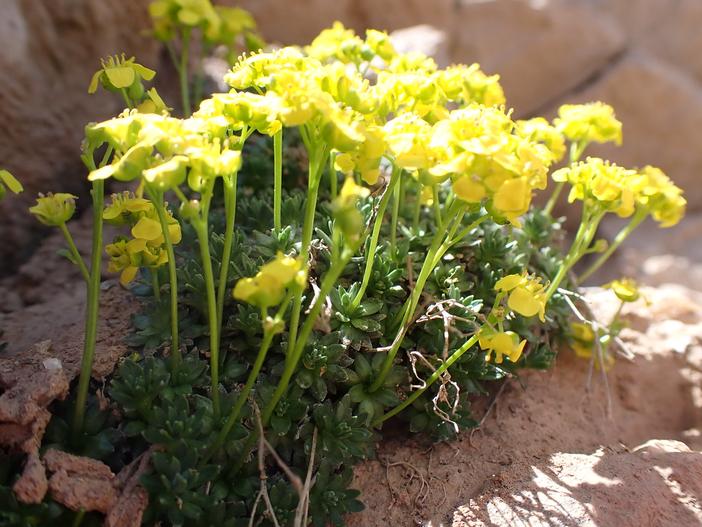Fewseed Draba
(Draba oligosperma)
Fewseed Draba (Draba oligosperma)
/
/

Matt Lavin
CC BY-SA 2.0
Image By:
Matt Lavin
Recorded By:
Copyright:
CC BY-SA 2.0
Copyright Notice:
Photo by: Matt Lavin | License Type: CC BY-SA 2.0 | License URL: https://creativecommons.org/licenses/by-sa/2.0/ | Uploader: Matt Lavin | Publisher: Flickr


































































Estimated Native Range
Summary
Draba oligosperma, commonly known as Fewseed Draba, is an evergreen perennial herb that thrives in alpine and subalpine zones, as well as arctic tundra, primarily in the Western United States and Northern Canada. It is a diminutive plant, typically reaching heights and widths of 0.3-0.6 feet (0.09-0.2 meters), and forms a low, cushion-like mound. Fewseed Draba is adapted to harsh, cold environments where it occupies rocky outcrops and well-drained slopes. The plant produces small, bright yellow flowers in the late spring to early summer, which are modest in size but can be quite numerous, creating a noticeable display against the green foliage.
Fewseed Draba is valued for its ability to thrive in rock gardens and alpine troughs, where its drought tolerance and low stature make it an excellent ground cover. It is also used in restoration projects in its native range to stabilize soils and support native pollinators. Gardeners appreciate its minimal water needs and its ability to grow in poor, rocky soils with excellent drainage. While it prefers full sun, it can tolerate some shade, especially in hotter climates. Fewseed Draba is generally free from major pests and diseases but can suffer from root rot if overwatered or planted in poorly draining soils. It is not known to be invasive and is considered a low-maintenance choice for suitable habitats.CC BY-SA 4.0
Fewseed Draba is valued for its ability to thrive in rock gardens and alpine troughs, where its drought tolerance and low stature make it an excellent ground cover. It is also used in restoration projects in its native range to stabilize soils and support native pollinators. Gardeners appreciate its minimal water needs and its ability to grow in poor, rocky soils with excellent drainage. While it prefers full sun, it can tolerate some shade, especially in hotter climates. Fewseed Draba is generally free from major pests and diseases but can suffer from root rot if overwatered or planted in poorly draining soils. It is not known to be invasive and is considered a low-maintenance choice for suitable habitats.CC BY-SA 4.0
Plant Description
- Plant Type: Herb
- Height: 0.3-0.6 feet
- Width: 0.3-0.6 feet
- Growth Rate: Moderate
- Flower Color: Yellow
- Flowering Season: Spring, Summer
- Leaf Retention: Evergreen
Growth Requirements
- Sun: Full Sun
- Water: Low, Medium
- Drainage: Fast
Common Uses
Drought Tolerant, Low Maintenance, Rock Garden, Showy Flowers
Natural Habitat
Native to alpine and subalpine zones, as well as arctic tundra in the Western United States and Northern Canada
Other Names
Common Names: Few-Seed Draba, Few-Seed Whitlowgrass, Glacier Draba, Drave À Fruits Groupés
Scientific Names: , Draba oligosperma, Draba oligosperma var. oligosperma, Draba juniperina, Draba oligosperma var. subsessilis, Draba oligosperma var. juniperina, Draba saximontana, Draba subsessilis, Draba andina, Draba oligosperma var. leiocarpa
GBIF Accepted Name: Draba oligosperma Hook.